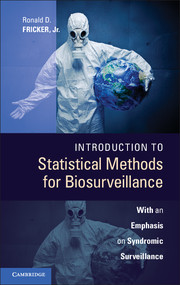Book contents
- Frontmatter
- Content
- Preface
- Acknowledgments
- Part I Introduction to Biosurveillance
- Part II Situational Awareness
- Part III Early Event Detection
- Part IV Putting It All Together
- 9 Applying the Temporal Methods to Real Data
- 10 Comparing Methods to Better Understand and Improve Biosurveillance Performance
- Part V Appendices
10 - Comparing Methods to Better Understand and Improve Biosurveillance Performance
from Part IV - Putting It All Together
Published online by Cambridge University Press: 05 March 2013
- Frontmatter
- Content
- Preface
- Acknowledgments
- Part I Introduction to Biosurveillance
- Part II Situational Awareness
- Part III Early Event Detection
- Part IV Putting It All Together
- 9 Applying the Temporal Methods to Real Data
- 10 Comparing Methods to Better Understand and Improve Biosurveillance Performance
- Part V Appendices
Summary
When I have fully decided that a result is worth getting I go ahead of it and make trial after trial until it comes.
Thomas A. Edison (1847–1931)This chapter builds on Chapter 9, synthesizing everything from the first eight chapters (and Appendix B) to demonstrate how to compare the performance of early event detection (EED) methods using simulation. Assessing EED performance via simulation is critical because, as shown in the last chapter, comparisons using real data are limited in a number of ways.
The first limitation is that real data are opaque and often unknowable. For example, it is virtually impossible to specify with certaintywhen a known outbreak starts and stops. It is similarly impossible to state with certainty that data for a given period is free of outbreaks. The entire point of EED methods and tools such as change point analysis is to find outbreaks, but failure to find an outbreak does not prove the absence of outbreaks.
The second limitation is that all real data are unique, both temporally and spatially. As a result, any analysis on one set of data is limited in terms of how generalizable the results might be for another time, or location, or under another set of circumstances.
- Type
- Chapter
- Information
- Introduction to Statistical Methods for BiosurveillanceWith an Emphasis on Syndromic Surveillance, pp. 281 - 302Publisher: Cambridge University PressPrint publication year: 2013



